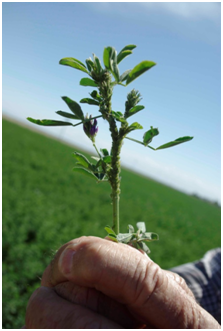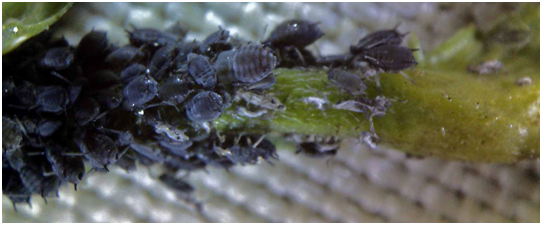
Cooler weather is ideal for pea and blue alfalfa aphid population growth. Distinguishing between the pea and blue alfalfa aphid is critical for proper treatment (see Godfrey's blog here, //ucanr.edu/blogs/blogcore/postdetail.cfm?postnum=9639). This can be done with a hand lens and using the ‘Aphids Found in Alfalfa' key located here, http://ceriverside.ucanr.edu/newsletters/December_201034750.pdf. Both aphids are blue-greenish in color (the pea aphid has a “pinkish” biotype that is less common). The aphids are easily separated by looking at their antennae. The pea aphid has 3 to 4 narrow dark bands (annuli) along the antennae which are tan in color whereas the antennae of the blue alfalfa aphid are uniformly brown.
Possible factors for our blue alfalfa aphid issue;
- High initial aphid populations
- Smaller than expected populations of predators and parasites; particularly the seven-spotted lady beetle
- May be weather related or pesticide related
- Potentially more insecticides applied to alfalfa than in the past; partially due to cowpea aphid
- Lack of “bio-rational” for weevil and aphid management in alfalfa
- Growers are spraying at the time of year when there are the fewest beneficial insects in alfalfa. The insecticides along with cool weather may be preventing or delaying the buildup of beneficial insect populations.
In October 2014, another widespread outbreak of aphids occurred in Kern County. Reports indicate that this outbreak is a complex of aphids, including pea, blue and cowpea. Depending on the location, proportions of each species can vary. Many acres have already been treated as populations have exceeded thresholds.
Eric Natwick, UCCE in Imperial County, continues to conduct testing for insecticide efficacy against blue alfalfa aphid and others. To date, the use of Lannate, dimethoate and Lorsban products have been the insecticides of choice by PCAs.
Beleaf 50SG insecticide recently acquired a 24(C) Special Local Need label and may be a useful tool for growers. The current drawback for use of Beleaf is a pre-harvest interval for alfalfa hay of 62 days.
Several other PCA observations:
- Green chop seems to reduce aphid pressure because alfalfa is removed immediately and aphids cannot buildup in windrows and attack regrowth.
- Some fields seen recently have low rates of parasitism, less than 10%. Adults and large larvae of lady bird beetles (Hippodamia) are observed in fields, but at very low levels.
Interested readers are encouraged to attend the California Alfalfa & Grains Symposium in Long Beach CA, December 10-12, 2014. Current research and management updates on alfalfa aphids will be presented. For more information, go to http://ucanr.edu/sites/Alfalfa/
Links to recent articles on Blue alfalfa aphid;
